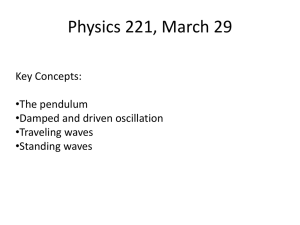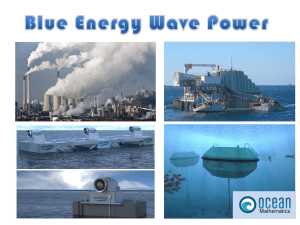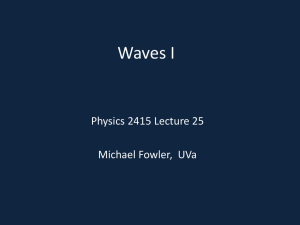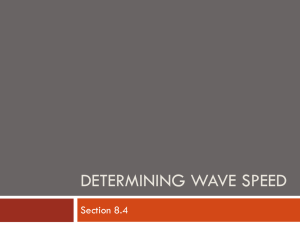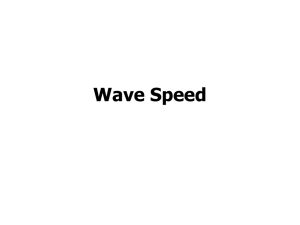(−x 2 )+ - tenaya.physics.lsa.umich.edu
advertisement
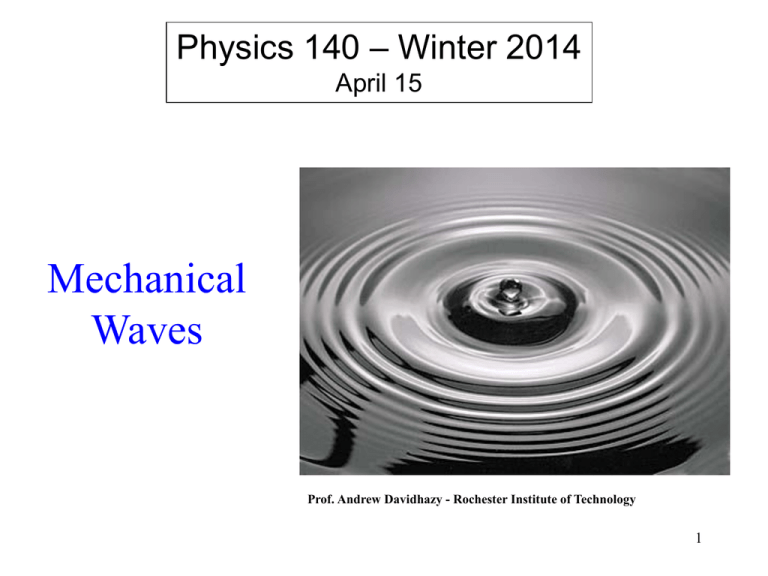
Physics 140 – Winter 2014 April 15 Mechanical Waves Prof. Andrew Davidhazy - Rochester Institute of Technology 1 Questions concerning today’s youtube video? 3 The Jacob’s Ladder demo illustrated torsional waves. What kind of waves are shown? A) Transverse B) Longitudinal 4 The table slinky demo can be used to illustrate what kind of waves? A) Transverse B) Longitudinal C) Both 5 When I hang this slinky by one end and then drop it, what will happen? 1) The bottom end of the slinky will immediately start falling at the same rate as the top. 2) The bottom end of the slinky will rise up, and the two ends will meet in the middle. Then the whole thing will fall to the floor. 3) The bottom end of the slinky will hang suspended momentarily, then start falling. Information that top is no longer supported travels down as a wave! Mathematics of a wave • Below is a graph of function f(x) = exp(−x2). Which mathematical operation needs to be applied to this function in order to have the pulse in this graph shifted by 2 units to the right? A. B. C. D. E. exp(−(x+2)2) exp(−(x−2)2) exp(−x2)+2 exp(−x2)−2 Some other operation Consider a wave pulse moving to the right with speed 2 units/second • Red = f(x) exp(−x2) t=0 Consider a wave pulse moving to the right with speed 2 units/second • Red = f(x) • Blue = f(x−v(1 s)) exp(−x2) exp(−(x−2)2) t=0 t=1s Consider a wave pulse moving to the right with speed 2 units/second • Red = f(x) • Blue = f(x−v(1 s)) • Green = f(x−v(2 s)) exp(−x2) exp(−(x−2)2) exp(−(x−4)2) t=0 t=1s t=2s Consider a wave pulse moving to the right with speed 2 units/second • • • • Red = f(x) Blue = f(x−v(1 s)) Green = f(x−v(2 s)) Yellow = f(x−v(3 s)) exp(−x2) exp(−(x−2)2) exp(−(x−4)2) exp(−(x−6)2) t=0 t=1s t=2s t=3s Right vs left motion • Thus, function f(x-vt) represents a pulse of shape f(x) travelling to the right with velocity v • Similarly, function f(x+vt) represents a pulse of shape f(x) travelling to the left with velocity v. f(x+vt)=f(x−(−vt)) Jerking a rope A man jerks a taut rope to produce a pulse that travels away from him at a speed v1. If he pulls the rope tauter and generates another pulse which moves away at speed v2, how do the speeds compare? A) v1 < v2 B) v1 = v2 C) v1 > v2 v F Hanging rope (non-negligible mass) A long rope with mass m is suspended from the ceiling and hangs vertically. A wave pulse is produced at the lower end of the rope, and the pulse travels up the rope. How does the speed of the pulse change as it moves up the rope? A. Increases B. Decreases C. Stays the same v F and F increases Tension F higher here (supporting more weight) String Composed of Two Parts A weight is hung over a pulley and attached to a string composed of two parts, each made of the same material but one having 4 times the diameter of the other. The string is plucked so that a pulse moves along it, moving at speed v1 in the thick part and at speed v2 in the thin part. What is v1/ v2? A. B. C. D. E. 1/4 1/2 1 2 4 v Ft 1 16 2 String Composed of Three Parts Three pieces of string, each of length L, are joined together end to end, to make a combined string of length 3L. The first piece of string has mass per unit length μ1, the second piece has mass per unit length μ2 = 4μ1, and the third piece has mass per unit length μ3 = μ1/4. If the combined string is under tension F, how much time does it take a transverse wave to travel the entire length 3L? 3 1 A. L 4 F D. 3L 3 1 B. L 2 F 1 F 18 1 C. L 7 F 7 1 E. L 2 F L t1 v1 L 1 L F F / 1 L t2 v2 L 2 4 1 L L 2t1 F F F / 2 L t3 v3 L 3 L 1 1 t L 1 4F 2 F F / 3 t total 1 7 1 t1 t 2 t 3 1 2 t1 L 2 2 F L μ1 L L μ2 = 4μ1 μ3 = μ1 / 4 17 Three waves on three strings • Three waves are traveling along identical strings under the same tension. • Wave B has twice the amplitude of the other two. • Wave C has half the wavelength of A or B. • Which wave moves v y A fastest? wave x A. B. C. D. E. Wave A Wave B Wave C Waves A and B (tie) All have same v y B x y C x Three waves on three strings • Three waves are traveling along identical strings under the same tension. • Wave B has twice the amplitude of the other two. • Wave C has half the wavelength of A or B. • Which wave has the v y A highest frequency? wave x A. B. C. D. E. v = λ/T = λf Wave A Wave B Wave C Waves A and B (tie) All have same v y B x y C x y k 2 m 1 and 4 s1 vx 2 m/s k x Leftward moving A wave traveling along a string (shown above) takes the form y(x,t) = A cos (2x + 4t) with x in meters and t in seconds. Imagine following the motion of the point of constant phase, P, as the wave evolves. After 2s elapse, where will point P be located? 1. 2. 3. 4. 5. (2 m/s)(2 s) 4 m at the same x position 2m to the right of its current position 2m to the left of its current position 4m to the right of its current position 4m to the left of its current position Wave vs particle speed A k ω • A wave travelling along a string takes the form y( x, t ) 5 cos(2 x 3t ) where x and y are in meters and t is in seconds. What is the ratio of the wave velocity to the maximal velocity of an oscillating particle on that string? A. B. C. D. E. 1/15 1/10 1/9 1/6 9/10 1 1 1 vwave / k kA 2 5 10 v p,max A L Hanging weight – part 1 W A 1.50-m string of weight 0.0125 N is tied to the ceiling at its upper end, and the lower end supports a weight W. When you pluck the string slightly, the waves traveling up the string obey the equation: k ω 1 1 v y(x,t) (8.50 mm)cos(172m x 4830s t) k How much time does it take a pulse to travel the full length of the string? Use A) B) C) D) E) 0.0072 s 0.0137 s 0.0534 s 0.0661 s 0.0945 s y(x,t) Acos(kx t) 4830 1 s1 v 28.1 m/s 1 k 172m L 1.50 m t 0.0534 s v 28.1 m/s 22 L Hanging weight – part 2 W A 1.50-m string of weight 0.0125 N is tied to the ceiling at its upper end, and the lower end supports a weight W. When you pluck the string slightly, the waves traveling up the string obey the equation: v y(x,t) (8.50 mm)cos(172m x 4830s t) What is the weight W? (The wavespeed we found is 28.1 m/s.) 1 1) 2) 3) 4) 5) 1 F 0.47 N v F F W v2 mstring v2 wstring / g v2 0.67 N L L 0.87 N 2 (0.0125 N) / (9.8 m/s ) 1.07 N 2 F (28.1 m/s) 1.27 N 1.50 m = 0.671 N 23 Hanging weight – part 3 L W A 1.50-m string of weight 0.0125 N is tied to the ceiling at its upper end, and the lower end supports a weight W. When you pluck the string slightly, the waves traveling up the string obey the equation: k y(x,t) (8.50 mm)cos(172m1x 4830s1t) How many wavelengths are on the string at any time? ( A) B) C) D) E) 11 21 31 41 51 1 2 L 2 L 1 kL 2 1 (172 m 1 )(1.50 m) 41. 2 24 Dependence on space and time y(x,t) Acos(kx t) A transverse sine wave with an amplitude of 2.50 mm and a wavelength of 1.80 m travels from left to right along a long, horizontal, stretched string with a speed of 36.0 m/s. Take the origin at the left end of the undisturbed string. At time t=0 the left end of the string has its maximum upward displacement. What is the velocity of a particle 1.35 m to the right of the origin at time t = 0.0625 s? 2 2 Hint: 1 k 3.49 m A) −0.20 m/s 1.80 m y(x,t) v (x,t) y B) 0.00 m/s t v kv C) +0.20 m/s k D) +0.40 m/s E) +0.60 m/s (3.49 m1 )(36.0 m/s) 126. s1 y(x,t) (2.50 mm)cos[(3.49m1 )x (126.25s1 )t] Dependence on space and time A transverse sine wave with an amplitude of 2.50 mm and a wavelength of 1.80 m travels from left to right along a long, horizontal, stretched string with a speed of 36.0 m/s. Take the origin at the left end of the undisturbed string. At time t=0 the left end of the string has its maximum upward displacement. What is the velocity of a particle 1.35 m to the right of the origin at time t = 0.0625 s? y(x,t) Acos(kx t) y(x,t) vy (x,t) ( )A[sin(kx t)] Asin(kx t) t vy (0.314 m/s)sin[(3.49m1 )(1.35m) (126. s1 )(0.0625s)] = (0.314 m/s)sin( 3.14) = 0. 26 Tossing an ant – exercise for home An ant with mass m is standing peacefully on top of a horizontal, stretched rope. The rope has mass per unit length μ and is under tension F. Without warning, a boy starts a sinusoidal transverse wave of wavelength λ propagating along the rope. The motion of the rope is in a vertical plane. What minimum wave amplitude will make the ant become momentarily weightless? (Assume that m is so small that the presence of the ant has no effect on the propagation of the wave.) AMin 2 g 4 2 F 27

